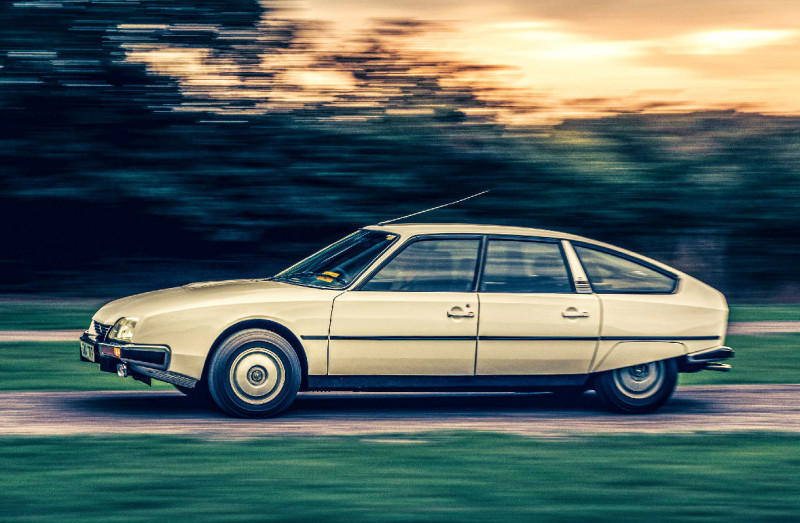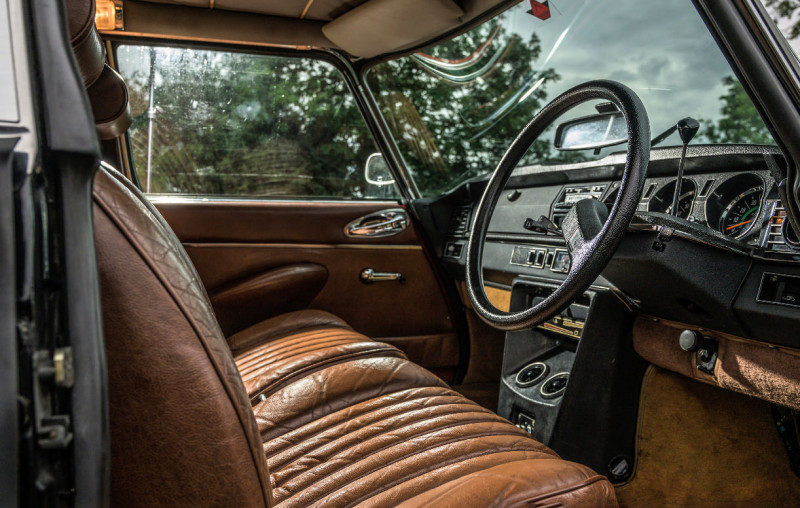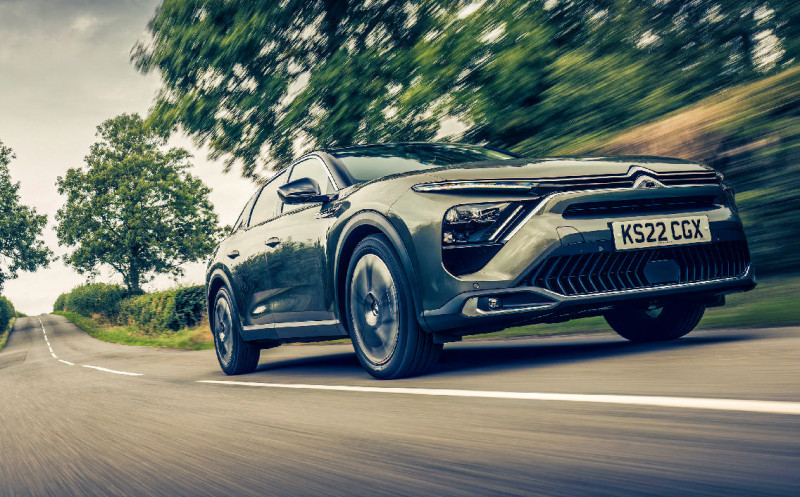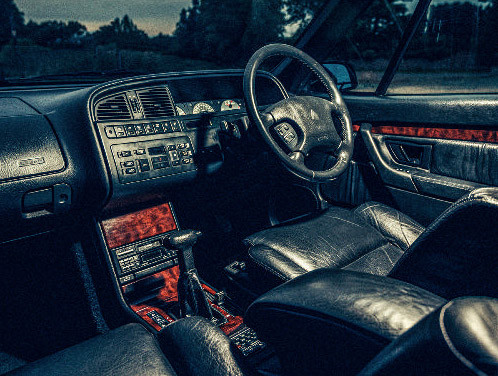Citroën DS, CX, Traction Avant, XM, C6 and new 2023 C5X
Citroën used to make the most ambitious, most modern, most innovative cars in the world. It’s now getting some of that spirit back.
Words Gavin Green
Photography Olgun Kordal
THE OLD FUTURE
The dying art of the big French luxury car, starring the Citroën DS, CX, Traction Avant, XM, C6 and new C5X

The world needs a Citroën right now. We need a bold car maker to set a new course for car engineering. Today’s numerous challenges, from carbon to congestion to cost, need the think-different audacity that once epitomised France’s greatest car maker. From its birth in 1919 to the mid ’70s – until it was subsumed by Peugeot – Citroën cars never followed convention. They challenged it. Rather than stepping cautiously, they strode boldly.

The apogee was the DS, the most modern car ever built, and still probably the world’s most streamlined-looking saloon. Into a post-war world of Morris Minors and Austin A30s, of Ford Consuls and Anglias, landed this futuristic French car with its spaceship style and stepahead technology.
Now, the world needs another big leap, to more striking and space-efficient designs. To new technologies that make electric cars as practical as petrol cars, and truly sustainable. To make them lighter and less costly.

André Citroën would surely have welcomed the challenge. So, too, would the architects of the DS: sculptor turned car designer Flaminio Bertoni and former aviation engineer André Lefèbvre.
Today Citroën is sadly a shadow of its former greatness. But at least, under Stellantis, it has rediscovered some of its mojo. The Ami is a fresh slant at urban EV driving. It’s small, light and has a commercial model as unusual as its style. The Oli concept (see CAR November) similarly challenges the EV status quo.

And now comes the C5X. It’s the latest big Citroën, the most recent in a noble line that goes back to the Traction Avant, the sublime DS and the CX. Roland Barthes would hardly describe it as ‘a superlative object’ that had ‘fallen from the sky’ as he did the DS. But equally this is no me-too car. Intriguingly, it’s a cross between an SUV and a fastback estate in its proportions and concept. It has hydraulic bump stops and active dampers for a cushioned ride. It prioritises comfort and relaxed driving over frenzied sportiness, as a good Citroën should. There are big and softly cushioned chairs and loads of rear legroom, another Citroën signature.

Our test car is the top-spec plug-in hybrid and, as with all goo PHEVs, the powertrain cycles between petrol and electric power seamlessly. Electric-only range is about 25 miles. It’s hardly sporty yet it handles tidily and accelerates briskly. If you want a big, practical five-seat car, laced with a few strands of SUV DNA, it’s a good choice. Decent value, too.
THE DS WAS THE MOST CLEVERLY ENGINEERED AND COURAGEOUS CAR OF ALL TIME
But to see whether it belongs in the Citroën big-car pantheon, we gathered its distinguished forebears. Including the C5X, that’s six cars, covering almost 90 years.
I have a particular soft spot for the car that begins our Citroën odyssey. I owned a 1953 Light 15 in the late ’80s and early ’90s. The Light 15 (as it was known in the UK) was part of the Traction Avant family, the last manifestation of the genius of André Citroën. He died a year after its launch, in 1935. André was an ambitious risk taker. Like Steve Jobs, he was an immigrant’s son, a visionary and a brilliant marketer. Unlike Jobs, he was also an engineer. Within a few years of its birth in 1919, his upstart little company was outselling much-older Peugeot. Yet by 1934 it would be bankrupt for the first (but not last) time, scuttled by over-ambition. The new Traction Avant was brilliant, popular but ruinously expensive to develop and build. It cost poor André his livelihood and very possibly his life. Citroën was sold to its largest creditor, tyre maker Michelin.

The Traction Avant was probably the greatest saloon of the ’30s, although as a former owner I may be biased. It had a pressed-steel unitary-construction body for added lightness and strength. Structurally, it was like a tin can. The roof and floor helped give it strength rather than merely insulate it from bad weather. This also saved 70kg of steel compared with separate chassis layouts. It was the world’s first commercially successful front-wheel-drive car and had fully independent suspension for superior ride and handling. There were four-wheel hydraulic brakes, an overhead-valve wet-liner engine and rubber engine mounts – all rare at the time.
Among many distinctive styling touches, it dispensed with running boards. Discarding a propshaft and a chassis meant it was much lower and more ground-hugging than the norm, one reason it looked so sleek and graceful. Another was that it had its wheels widely separated and was delightfully free of overhang and flab. Its various technical innovations made it lighter, roomier and more stable than any rival. Our test car is a late 1955 French-built model painted in the same comely shade of burgundy red that adorned my own car. Owner Sara Fleming is the daughter of an avid Citroën collector. Oh the joy of being reacquainted with a Traction again! For a ‘big’ Citroen it isn’t really that big, at least by modern standards: at 4.4 metres it’s just a touch longer than the (much less roomy) current Ford Focus. (The new C5X is 4.8 metres.) The front doors are rear-hinged for easier access and the driver’s seat is softly cushioned and very comfortable.

As you drive, you look out over a large Bakelite-rimmed steering wheel and a characterful painted metal dashboard, populated by lovely art deco Jaeger instrumentation. You also look out over a long and graceful bonnet, a chrome strip running down its centreline. Underneath is a four-cylinder 1.9-litre engine of a modest 54bhp.
THE C6 IS THE LEAST COMMERCIALLY SUCCESSFUL BIG CITROËN BUT ALSO THE MOST UNDERESTIMATED
It is an exceedingly handsome car and you are continually greeted by well-wishers – one of the joys of classic car ownership. Ride comfort is excellent, far better than almost any modern. Sara’s car has the Michelin X radial tyres specially developed for the Traction. They are a key reason why the Traction rode, handled and gripped far better than contemporaries. The rear seat is like a small comfy sofa; legroom is excellent. Yet a car that was engineered back in the early ’30s clearly shows its age. It is slow: 0-60mph in a touch under 30 seconds, and top speed just over 70. Its engine is noisy, and the dash-mounted gearshift moves ponderously from cog to cog. Plus, there are only three speeds. Turning circle, too, is terrible. The brakes are heavy and poor by today’s standards. Discs came with the next-generation big Citroën, the DS.
If the Traction was 10 years ahead of its contemporaries, then the DS – launched in 1955 – was decades ahead. It was the most cleverly engineered and courageous car of all time, setting new standards in ride, handling and braking. High-pressure hydraulics powered the self-levelling suspension, the brakes, the clutch and the gearshift (you changed gears manually but there was no clutch pedal). It was the first mass-produced car to use disc brakes (mounted inboard at the front to reduce unsprung weight). Later came directional headlamps. A 1968 Robert Opron-designed facelift gave it an even more distinctive shark-like nose, which continued in production until DS sales finished in 1975.

Unlike the electric Tesla Model S that would subsequently revolutionise the car industry, the DS did not inspire car makers to follow its numerous technical advances. Instead, it merely gratified almost 1.5 million owners and will no doubt continue to stimulate car enthusiasts and designers for generations to come.
One such owner is Shaun Lilley, who kindly loaned us his 1975 DS for this story. Take up station behind the distinctive single-spoke steering wheel and sink into the softly cushioned seats. So comfortable, like an old and much-loved lounge chair. Start the 2.3-litre fuel-injected four-cylinder engine by, idiosyncratically, using the delicate chromed gear wand which rises north from the steering column. Push it to the left, and the engine bursts into life.
Move off, on a Warwickshire B-road, and the cushioned ride is quite astonishing. You sail over a broken road like the QE2 navigating a swell.
Bumps are often imperceptible, as you levitate over the tarmac. No other car isolates you so completely from what’s happening beneath. Yet the hydraulic steering is feelsome and sharp, and handling is good. Braking is by a pressure-sensitive hydraulic button rather than a conventional pedal. Pedals can cause terrible foot injuries in accidents, so a button is safer. It works well, although sensitivity is needed. Directional stability is outstanding. So is all-round visibility, helped by the wrap-around windscreen, low beltline and slim pillars. Less impressive is the engine: by the ’70s the pushrod four-cylinder felt harsh and rough. In fact, the DS was originally intended to use a new flat-six, canned because of cost.
Shift gear by moving the chromed wand, sited on top of the steering column. The clutch engages automatically. There are four speeds, and shifting is slow. But it’s easy to use, and quick to master. Rear comfort is outstanding, like sitting in a favourite lounge sofa.
When DS production ended (in France, on 24 April 1975), the big Citroën baton passed to the CX. For many, this was the last great Citroën and the last ‘real’ Citroën. It was certainly the last big Citroën engineered before Peugeot’s stifling stewardship commenced in 1976. The CX was a fresh reimaging of all that made the DS so wonderful. The new body was more aerodynamic, and new features included a concave rear window, designed to clear rain without the need for a wiper. Technical upgrades included a transverse rather than a longitudinally mounted engine. It was originally designed to use a rotary. The ’70s fuel crisis quashed that idea: rotary engines are delightfully small, light and turbine smooth, but they guzzle gas. The steering was now speed-sensitive, self-centring and faster geared, similar to the wonderful SM coupe.
Neil and Janice Osborn’s 1979 CX is the 2.4-litre GTi version (a GTi turbo came in 1985). The soft brown velour upholstery is so very ’70s, and the seats are squishy and easy-chair comfortable. There’s a single-spoke wheel, as with the DS. The ‘spaceship’ design has spread to the futuristic interior. There is a rotating-drum speedo and rockers replace column stalks. All major controls are clustered around the steering wheel. Visibility is excellent. Rear sear room and comfort are also superb, although you don’t sit as armchair-upright as in a DS. It’s quieter and more refined than the DS, and sharper handling too.
The CX’s successor, the XM of 1989, was a big Citroën of similar character but very different style. The lineage was still clear, including hydropneumatic suspension, now semiactive. Sensors measured bumps and reacted within 0.05sec to adjust damping and springing. They also monitored speed, body movement, braking effort, steering angle and more.
The XM was also roomy and comfortable, as big Citroëns invariably are. Yet the style was now flat-surfaced and wedgy, mirroring the look of the smaller BX. If we exclude the Commerciale version of the Traction Avant, it was the first big Citroën hatchback.
The interior was more conventional than the other-worldly CX, although trim and build quality were better. Engines now included new four-cylinders and a creamy smooth V6. It also rode on a Peugeot platform, which meant the use of MacPherson struts rather than the wishbones found on the DS and CX.
Ride comfort remained outstanding, as a short drive in William Oxer’s 3.0-litre 24-valve V6 car quickly shows. Performance is a leap forward over the DS and CX, as is mechanical refinement.
Alas, sales were a giant leap backwards. The Germans now dominated the premium saloon market, and the waning glory of the Citroën badge and some early reliability niggles were enough to consign the XM to the sales scrapheap. It also increased nervousness about launching a replacement. This was delayed to 2005, five years after XM production ceased. The C6 that emerged is the least commercially successful big Citroën – a miserly 22,000 cars sold in six years. It is also the most underestimated. It was handsome, curvaceous and streamlined, regaining the styling flair of the DS and CX.
It was technically adventurous, from its supple and sure-footed Hydractive suspension to its xenon directional headlamps. Some of its pioneering tech would soon become mainstream, including a head-up display and lanedeparture warning. It was a beautiful car, technically daring and stylistically avantgarde. But the premium buyer had moved on to German cars.
The C6 is one of my favourite Citroëns and, as owner Shaun Lilley (also keeper of our DS) points out, a car that’s almost impossible to replace. What new car is remotely like it? The C5X partly fills the void. It may lack the grace of the older big Citroëns, nor does it waft with the same smug indifference to road irregularities. But it’s comfortable and roomy, and feels like a traditional big Citroën – never mind that it’s made in China.
The chevron brand has finally found its niche again: as the maker of mildly idiosyncratic cars focused on comfort. Citroën may no longer seek to reinvent the automobile, as so many of its forebears nobly did. But at least, as the little Ami city EV shows, there’s still a pleasingly contrarian Parisian streak that, just occasionally, still shines bright.
Grille leaves you in no doubt C5X is a Citroën, but is it true to the heritage? C6 was quirky and agreeable, but buyers had gone German.
Transverse engine means shorter CX is as roomy as a DS Even a late DS has charm to spare.
Unhelpful resemblance to Xantia didn’t help XM sales.
THE CX WAS THE LAST BIG CITROËN ENGINEERED BEFORE PEUGEOT’S STIFLING STEWARDSHIP COMMENCED
WHAT’S FRENCH FOR DELUXE?
As a walk down the Champs-Élysees reveals, France rules the luxury world: from Louis Vuitton luggage to Hermès handbags, from Chanel fragrance to Cartier jewellery. But there are no successful French luxury car marques. Rather, it’s German-owned, British-made Rolls-Royce and Bentley that dominate the top end. Germany clearly rules in mass premium. Nobody gets close to BMW, Mercedes-Benz or Audi.
It wasn’t always so. Before the last world war, France built some of the world’s most distinguished luxury cars. They included Delahaye, with its handsome streamlined models; Delage (pictured), once favoured transport of French presidents; pioneering Panhard; Hotchkiss; Talbot-Lago; Bugatti. They all died soon after the last war. Only Bugatti survives, resurrected in 1998 as a tiny-volume maker of ridiculously rapid hypercars. After the war, the French state – never averse to industry meddling – rationalised its car business. Successful volume makers such as Renault and Citroën were favoured. Punitive taxes were introduced on powerful cars. The luxury car market collapsed. By the mid ’50s, France’s automotive royalty had vanished.
NEED TO KNOW
The story so far…
André Citroën launches his own car company, which quickly outsells Peugeot. His 1934 Traction Avant is one of the great pre-war cars, but its huge development costs bankrupt Citroën. Michelin takes over and more brilliant cars follow until bankruptcy number two sees Peugeot take control.
Explain the ranking…
Top 10 mostly because of its stellar past: 2CV, DS, GS, SM, CX, H-van… the list goes on.
Citroën in three words…
Always think different.
Best car…
The DS is surely the biggest single design and technical leap in car history.
Darkest hour…
Bankrupt twice. Plus at one stage it was Peugeot’s budget brand.
The future looks…
Assured, as Stellantis’ moderately quirky comfort-led brand.
So very French that it should be a crime to drive it on the left. Not for show – CX aero was developed in the wind tunnel. If by GTi you mean massive brown chairs, this CX is a GTi.
UNDER STELLANTIS CITROËN HAS REDISCOVERED SOME OF ITS FORMER MOJO
TECHNICAL DATA CITROEN TRACTION AVANT
- YEARS BUILT 1934-1956; 333,405 made
- POWERTRAIN 1.3-litre four-cylinder, 2.9-litre six-cylinder
- PERFORMANCE 32-77bhp, 60-80mph
- WEIGHT 1025-1170kg
TECHNICAL DATA CITROEN DS
- YEARS BUILT 1955-1975; 1,456,115 made
- POWERTRAIN 1.9/2.4-litre four-cylinder
- PERFORMANCE 74-128bhp, 118mph
- WEIGHT 1270-1384kg
TECHNICAL DATA CITROEN CX
- YEARS BUILT 1974-1991; 1,169,695 made
- POWERTRAIN 2.0/2.5-litre four-cylinder
- PERFORMANCE 101-168bhp, 93-137mph
- WEIGHT 1265-1520kg
TECHNICAL DATA CITROEN XM
- YEARS BUILT 1989-2000; 333,405 made
- POWERTRAIN 2.0-litre four-cylinder, 3.0-litre V6
- PERFORMANCE 82-197bhp, 107-146mph
- WEIGHT 1310-1550kg
TECHNICAL DATA CITROEN C6
- YEARS BUILT 2005-2012; 23,384 made
- POWERTRAIN 2.7/3.0-litre V6
- PERFORMANCE 168-237bhp, 142-146mph
- WEIGHT 1816-1871kg
TECHNICAL DATA CITROEN C5X
- YEARS BUILT 2022-2025
- POWERTRAIN 1.2/1.6-litre four-cylinder, 1.6-litre plug-in hybrid
- PERFORMANCE 128-222bhp, 130-145mph
- WEIGHT 1905-2185kg



Citroën vs BMW
I enjoyed reading your excellent feature on Citroën 60 countdown. I was lucky enough to own a 1986 CX GTi Turbo 2 for 10 years until 1998. This was an amazing and underrated machine, hard to own, easy to love, a pleasure to waft in, weird to corner at speed. Its quirks were numerous, as if Salvador Dali had managed the production line. Exterior trim was held on by sticky typewriter ribbon, the boot hinge broke and appeared to come from a factory that made suitcase catches. Despite these flaws, its sleek long body turned discerning heads, and is still a lesson in how a car could be futuristic and beautiful. In contrast to Citroën’s elegant approach to design, look at your second fave marque, BMW, whose stylist seems hellbent on giving us cars that would make dogs weep. The DrivesToday team has obviously fallen underthe spell of this brand, which now produces some of the least attractive cars they’ve ever come up with. The bulbous i7 looks like a cutand- shut of three post-war Rovers. The grungy M2 with nose parts modified from a Dodge truck. The macho iX with a bodykit made from a bag of Darth Vader helmets. Citroën proves it’s good to be different and innovative, if not always perfect dynamically. Kia and Hyundai prove you can build technologically advanced cars that also look good. Why can’t BMW do this like they used to?